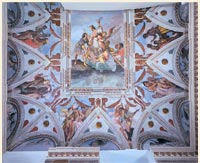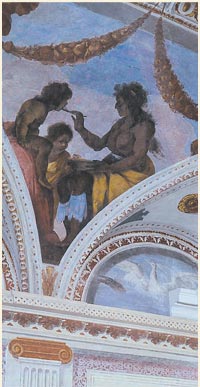For the visitors as well as for the residents of Genoa it is quite exciting to view these lively and very pleasant works of art by Strozzi, frescos hidden for so long that they were considered lost by now.
Even the special iconographic choice is absolutely fascinating: the center of the composition, in the form of a "painting within a painting", represents a nobleman helping a young woman - recognized as an allegory of the Christian faith - caught the instant she's getting off a ship onto the dry land.
The gentleman, standing up and already disembarked, holds in his hand an astrolabe that identifies him as a navigator, while Faith, accompanied by two angels, stands out as a visual and symbolic fulcrum, lifting up a golden chalice with a cross on top. According to Newcome's interpretation, the four elderly men portrayed next to Faith, holding in their hands valuable bound texts, may in fact represent the four Evangelists, and the scene could be interpreted as an allusion to the discovery of the Americas in 1492.
According to the same scholar, then, this image may serve to recall the ancient friendship between Christopher Columbus and the Centurione family, who in 1478-1479 turned precisely to the great navigator in order to have a large quantity of sugar shipped from Madera, sugar that was then supposed to be resold in the Ligurian city.
The discovery of the Americas was already celebrated in 1607 in the city of Genoa by Lazzaro Tavarone in two rooms of the Bombrini palace and, around 1620, in the Bellimbau palace, previous examples that Strozzi looked at without a doubt.
This theme, certainly agreed upon with the same Luigi Centurione, allowed the painter to let his imagination run wild with strange and fantastic subjects lit up with brilliant and vibrant color schemes. In the lunettes we also see a wide variety of birds, even exotic ones, which are not only the figment of the painter's imagination but certainly derive from reproductions of real images. This is not unusual if we consider that in the sixteenth century Genoa and Antwerp were home to the most important bird markets in the world.
In the pendentives, on the other hand, we see hunting and working scenes of the Indio population, scenes of cruel cannibalism next to tender images of motherly love, all related to the indigenous world.
Here the painter gives proof of his skill in applying color with vibrant and energetic brushstrokes, in quick traits on the already-dried fresco, showing his ability in the proper use of a mixed technique according to a procedure that had become popular even in Genoa, after the example of Perin del Vaga at the Andrea Doria palace.
Francesca Boschieri usefully reminds us that Centurione had financed Columbus' travels to the New World, and that the family's motto was 'Sola fides sufficit'- 'Faith is enough'- which, in light of this fresco, could be interpreted as an excellent synthesis of the entire representation. According to this letter, the gentleman in old-fashioned garments may very well be a member of the same Centurione family, whose colors appear in his dress, represented here as an advocate of the Church.

Bernardo Strozzi, Main room, "Sola fides sufficit" - "Faith is enough".

Bernardo Strozzi, Main room, detail of the pendentive.
